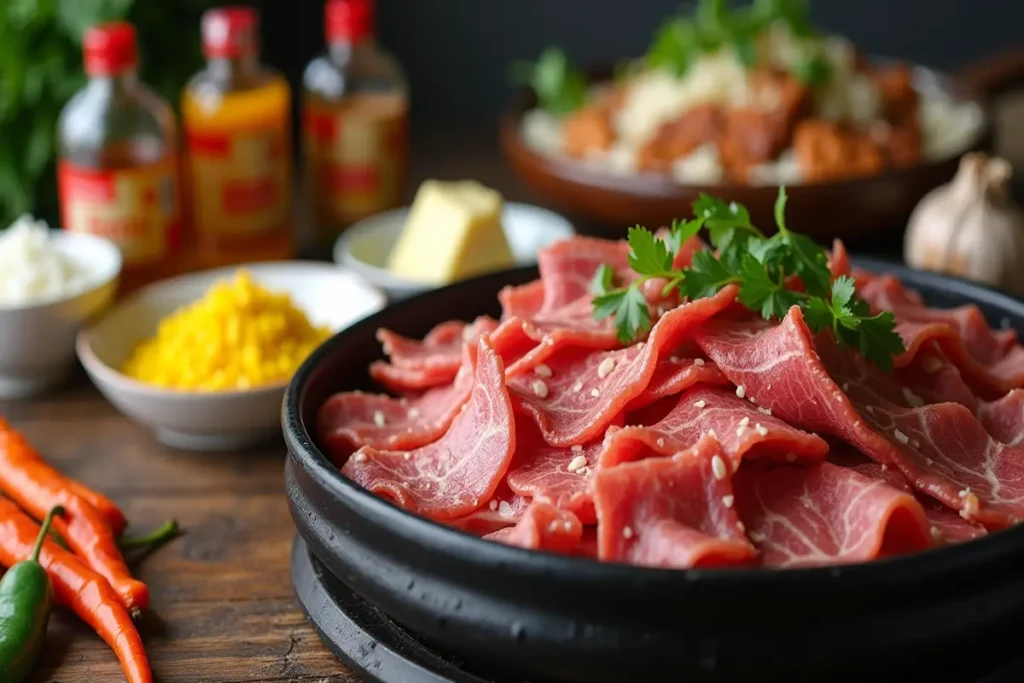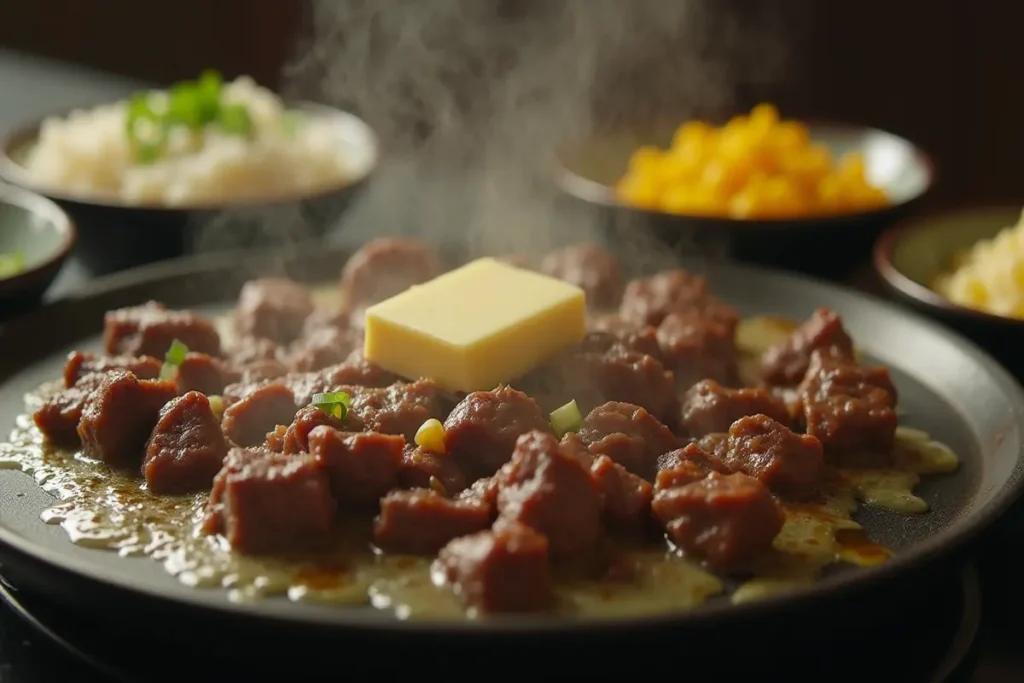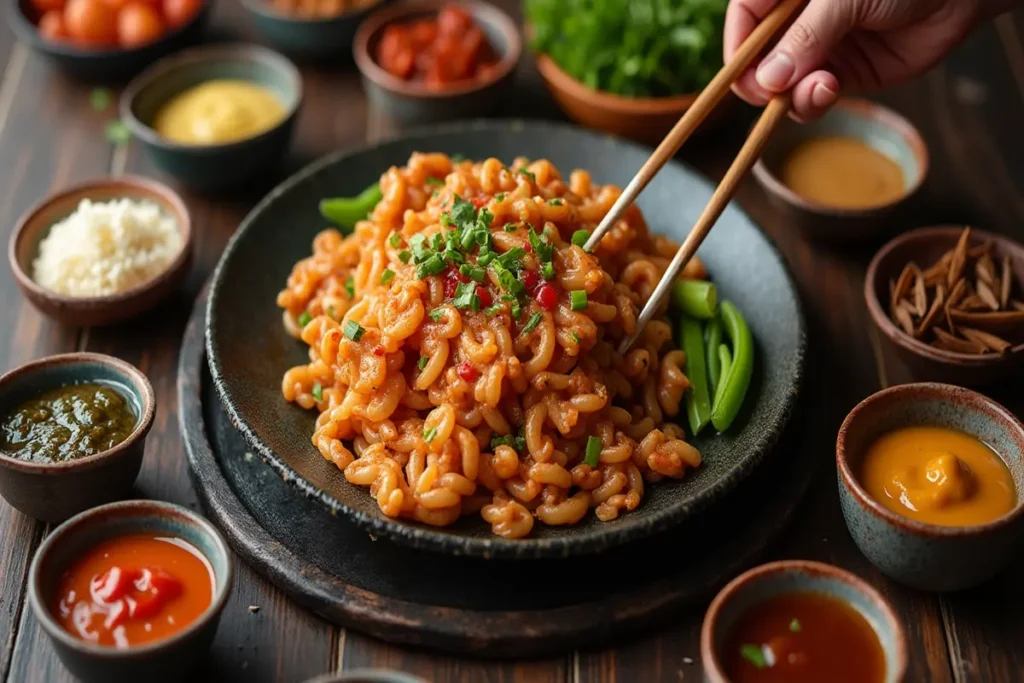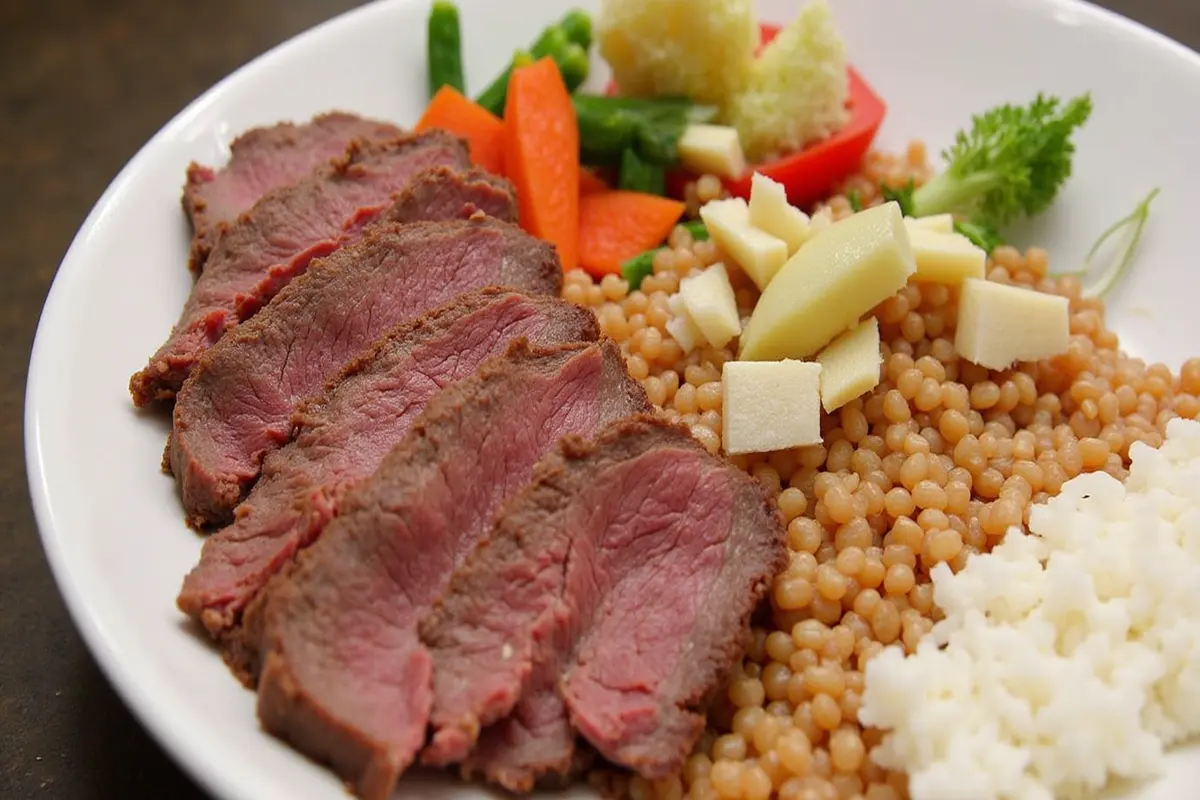Discover what is pepper lunch made of, including its key components and variations, in this comprehensive guide.
Table of Contents
Understanding the Core Ingredients
Pepper Lunch as a Complete and Balanced Meal What Is Pepper Lunch Made Of?
Pepper Lunch is a popular Japanese fast-food dish known for its sizzling hot plate presentation. So, what is pepper lunch made of? The core elements include thinly sliced meat, usually beef, a mix of vegetables, rice, and a savory sauce. These components are cooked together on a hot iron plate and served immediately. Therefore, its simplicity and the interactive cooking experience are key to its appeal. Moreover, its customizable nature makes it a popular choice.
The Essential Protein: Beef and Alternatives
The most common protein used in pepper lunch is thinly sliced beef. However, other options such as chicken, pork, or even shrimp are also available. So, what is pepper lunch made of when not using beef? The choice of protein greatly influences the overall taste. Specifically, the meat needs to be thinly sliced to cook quickly on the hot plate. Furthermore, different proteins offer unique flavor profiles to the dish.
Why Thinly Sliced Beef is Preferred
Thinly sliced beef is preferred because it cooks rapidly and evenly on the hot plate. Furthermore, it allows the flavors of the seasonings to penetrate the meat effectively. For example, ribeye or sirloin are popular choices. Thus, the thin slices are an important part of this dish. Additionally, the quick cooking time of thin slices contributes to the sizzling presentation.
Alternative Protein Options: Chicken, Pork, and Seafood
While beef is traditional, you can easily find pepper lunch made with other proteins. For instance, chicken thighs are a good alternative, as are thinly sliced pork. Additionally, shrimp or other seafood options provide variety. Therefore, diverse protein choices add to the dish’s flexibility. Moreover, these alternatives offer different textures and flavors.
The Role of Vegetables in the Dish
Vegetables add texture, flavor, and nutrients to pepper lunch. Usually, onions, corn, and scallions are used. But, what is pepper lunch made of when considering vegetables? Other options such as bell peppers, mushrooms, or zucchini can be included, according to preference. Consequently, fresh vegetables are essential to this dish. Furthermore, the freshness of the vegetables contributes to the overall appeal.
Common Vegetable Choices: Onions, Corn, and Scallions
Onions, corn, and scallions are common vegetables in a traditional pepper lunch. Therefore, these add a balance of sweetness and sharpness. Furthermore, these are ingredients that complement the dish’s other flavors. Moreover, they are quick to cook. Additionally, these vegetables provide important nutrients to the meal.
Customizing with Optional Vegetables
You can customize your dish with a variety of other vegetables. Thus, bell peppers add color and a touch of sweetness. Also, mushrooms contribute an earthy flavor. Likewise, zucchini offers a mild and fresh taste. Accordingly, these additional vegetables help create a unique dish. Indeed, these additions allow for personalization of the meal.
The Importance of Rice

Rice is a staple in pepper lunch, providing a base for the other ingredients. So, what is pepper lunch made of without rice? It would be incomplete. Usually, short-grain white rice is served with the meal. Therefore, the rice soaks up the flavorful sauce and complements the other ingredients. Furthermore, rice provides essential carbohydrates for energy.
The Specific Type of Rice: Short-Grain White
Short-grain white rice is the most common type of rice served with pepper lunch. Specifically, this type of rice has a slightly sticky texture. Consequently, it is easy to eat with the other components of the dish. Furthermore, this type of rice is very popular in Japanese cuisine. Moreover, the slightly sticky texture helps the rice to cling to the sauce.
Serving Style: How the Rice Complements the Dish
The rice is typically served on the side or as a base for the meat and vegetables. Thus, it is meant to be combined with the other ingredients, absorbing the flavors of the sauce. Hence, serving the rice correctly is a key element of this dish. Indeed, the way the rice is served is part of the visual appeal.
The Crucial Sauce Component
The sauce is what brings all the elements together in a pepper lunch. Therefore, it is typically savory, slightly sweet, and often contains soy sauce, mirin, and other seasonings. So, what is pepper lunch made of when it comes to the sauce? The sauce is a key flavor component. In addition, the sauce adds moisture and enhances the taste of the other ingredients.
Key Sauce Ingredients: Soy Sauce, Mirin and More
The sauce usually combines soy sauce, mirin, and sake (optional). Sugar is added for a touch of sweetness, and garlic for depth. Therefore, these ingredients create a complex flavor profile. Moreover, it provides a balance of sweet, savory, and umami notes. Indeed, the balance of these flavors is essential for the overall taste.
Exploring Sauce Variations
While the base ingredients are similar, variations in the sauce can occur. For example, some recipes might include ginger, or a touch of chili for added spice. Additionally, the proportions of each ingredient may vary. Hence, each variation offers a slightly different taste. Furthermore, these variations allow for a unique and personalized flavor experience.
The Sizzling Hot Plate: A Signature Cooking Method

The sizzling hot plate is a key feature of pepper lunch, adding to the interactive dining experience. So, what is pepper lunch made of in terms of cooking equipment? The hot plate is crucial. Therefore, the ingredients are cooked directly on the plate and served still sizzling. This cooking method ensures the food is cooked quickly and retains its moisture. Furthermore, the sizzling aspect adds to the overall excitement of the meal.
Why a Hot Plate is Essential
The hot plate needs to be preheated before the ingredients are added. This creates the signature sizzle and ensures the meat and vegetables are cooked properly. Consequently, it’s an important part of the experience. Additionally, the heat ensures that the ingredients are cooked quickly and evenly.
Cooking Technique: Searing on the Hot Plate
The meat and vegetables are cooked directly on the hot plate, allowing them to sear quickly. The sauce is added towards the end of cooking. This ensures the meal is served hot and freshly cooked. Thus, the cooking process is part of the allure of this dish. Moreover, the direct cooking on a hot plate creates a unique and enjoyable experience.
Seasonings and Spices
Besides the main sauce, seasonings and spices play a role in enhancing the flavors of pepper lunch. So, what is pepper lunch made of in terms of extra flavors? Salt and black pepper are basics, while other spices can be added for variation. Therefore, a balance of seasonings complements the other flavors. Furthermore, these seasonings help to bring out the natural flavors of the other ingredients.
The Basics: Salt and Pepper
Salt and black pepper are used to season the meat and vegetables before cooking. Thus, these enhance their natural flavors. Furthermore, they are essential elements for any recipe. In addition, these basic seasonings help to create a balanced flavor profile.
Optional Spices for Flavor
Some variations may include garlic powder, ginger, or chili flakes for an extra kick. Also, the spices can help customize the dish to personal taste. Hence, these options provide further ways to adjust the flavor. Indeed, the use of various spices can elevate the taste of the meal.
Cooking Oils and Their Role
Cooking oils are important in the cooking process of pepper lunch, to prevent the ingredients from sticking and to assist with cooking. So, what is pepper lunch made of in terms of oils? Usually, a neutral oil is used, such as vegetable or canola oil. Therefore, this allows the other flavors to stand out. Moreover, the oil helps the ingredients to cook evenly.
Suitable Oil Options: Vegetable or Canola
Oils with a high smoke point are ideal for cooking on a hot plate. Therefore, vegetable or canola oil are good choices. Specifically, these oils don’t add unwanted flavors to the dish. Moreover, they ensure proper cooking. Additionally, these oils help to create a crispy exterior on the meat and vegetables.
Avoiding Strong Flavors: Oil Selection
It is best to avoid oils with strong flavors, like olive oil. These can interfere with the desired flavors of the meat, vegetables, and sauce. Thus, neutral-flavored oils are preferred for this dish. Indeed, the use of neutral oils helps to maintain the intended flavor profile.
Regional and Restaurant Variations
Pepper lunch is a customizable dish, and variations exist in different locations and restaurants. So, what is pepper lunch made of in these varied preparations? The basic components are always present. However, the specific ingredients and their proportions can vary. Therefore, this allows for many variations of this popular meal. Furthermore, these variations add a unique touch to each locale.
Exploring Regional Adaptations
Regional adaptations of pepper lunch might include unique local ingredients. In addition, different sauces or vegetable combinations may be used. Thus, these regional variations reflect local preferences. Moreover, these variations can showcase the diversity of local cuisine.
Restaurant-Specific Versions
Many restaurants that serve pepper lunch have their own special versions. Therefore, they may use different cuts of meat or a proprietary sauce. Consequently, these differences make each restaurant’s version unique. In addition, these specific restaurant variations create a competitive and diverse food scene.
Pepper Lunch as a Complete and Balanced Meal

Pepper lunch is designed to be a complete meal, containing protein, vegetables, and carbohydrates. So, what is pepper lunch made of that makes it a complete meal? It’s the combination of all the different components. Therefore, it is balanced and satisfying. Furthermore, it offers the essential nutrients for a complete meal. Indeed, the meal is designed to be both satisfying and nutritious.
The Balance of Nutrients: Protein, Vegetables, and Carbs
The combination of meat, vegetables, and rice provides a good balance of nutrients. Specifically, the meat provides protein, while the vegetables offer vitamins and minerals. Additionally, the rice is a source of carbohydrates. Moreover, this balance is important for a healthy and fulfilling meal.
Convenience and Satisfaction
The quick preparation and balanced nutrition make pepper lunch a popular choice. Thus, it is a convenient meal for a quick lunch or dinner. Also, it’s satisfying and delicious. Furthermore, it provides both convenience and a tasty meal option.
Customizing Your Dish
One of the best features of pepper lunch is its customizability. So, what is pepper lunch made of that allows for such personalization? The various options for protein, vegetables, and sauce. Therefore, you can adjust the ingredients to suit your preferences. Furthermore, this makes it easy to cater to dietary needs. Additionally, this makes it suitable for many different preferences and dietary needs.
Adjusting Key Ingredients: Protein, Vegetables, and Sauces
You can choose your preferred protein, vegetables, and sauces to create your perfect dish. Therefore, this makes it a very adaptable dish. Also, it allows you to create a personalized meal every time you make it. Indeed, the ability to choose your ingredients makes each meal unique.
Adding Extra Toppings
Additional toppings, such as sesame seeds, pickled ginger, or scallions, can enhance the final product. Moreover, these can add extra flavor and texture. Thus, toppings add even more customization. Furthermore, these toppings add layers of texture and flavor to the final dish.
Making Pepper Lunch at Home
While it’s a popular fast-food dish, pepper lunch can be easily made at home. Therefore, it involves preparing the basic components and using a hot plate or a skillet. So, what is pepper lunch made of when prepared at home? It maintains the core elements with fresh and customized ingredients. Indeed, making it at home allows for control over the ingredients.
Essential Equipment for Home Preparation
A hot plate or a cast iron skillet is essential for cooking the meat and vegetables. Furthermore, a good cutting board and a sharp knife are required for prepping the ingredients. Hence, you need minimal equipment. Moreover, these are common items that many home cooks already have.
Tips for Home Cooking Success
When making it at home, be sure to heat the pan or hot plate properly. Don’t overcrowd it and cook the ingredients in batches if necessary. Also, add the sauce at the end for the best taste. Therefore, these steps ensure best results. Furthermore, using the right techniques ensures a restaurant-quality result at home.
The Sensory and Cultural Experience
Beyond just the taste, the experience of eating pepper lunch is a multisensory one. The sizzling of the meat on the hot plate, the aroma of the cooking ingredients, and the combination of textures all contribute to its appeal. Thus, it is more than just a meal; it is a unique experience. Indeed, these elements enhance the overall enjoyment of the dish.
The Cultural Significance
Pepper lunch, while a modern fast-food concept, also reflects aspects of Japanese culinary traditions. It highlights the emphasis on fresh ingredients, quick cooking methods, and balanced flavors. Therefore, it has become an important part of Japanese fast-food culture. Furthermore, its appeal has transcended cultural boundaries.
Health Considerations
While pepper lunch offers a balanced meal, it’s important to consider the ingredients and preparation methods. Choosing lean meats, a variety of vegetables, and controlling the amount of sauce will contribute to a healthier meal. Therefore, make informed choices to keep this a healthy option. In addition, paying attention to portion sizes is important.
Final Thoughts: What is Pepper Lunch Made Of?
In summary, pepper lunch is a delicious and customizable dish that combines simple ingredients. So, what is pepper lunch made of? It is made up of thinly sliced meat, a mix of vegetables, rice, and a savory sauce, cooked on a hot plate. Therefore, this combination of elements creates a unique and satisfying meal. Ultimately, its simplicity and customizable nature make it a popular meal. Moreover, it provides a great balance of flavors and textures.
Frequently Asked Questions (FAQs)
What is the main ingredient in Pepper Lunch?
The main ingredient in Pepper Lunch is usually thinly sliced beef. However, chicken, pork, or seafood options are also popular.
What kind of sauce is used in Pepper Lunch?
The sauce is typically savory and slightly sweet, made with soy sauce, mirin, and other seasonings like sugar and garlic.
What type of rice is served with Pepper Lunch?
Short-grain white rice is the most common type of rice served with Pepper Lunch.
Can I add other vegetables to Pepper Lunch?
Yes, you can add other vegetables such as bell peppers, mushrooms, or zucchini, depending on your preference.
FORE MORE RECIPES:

